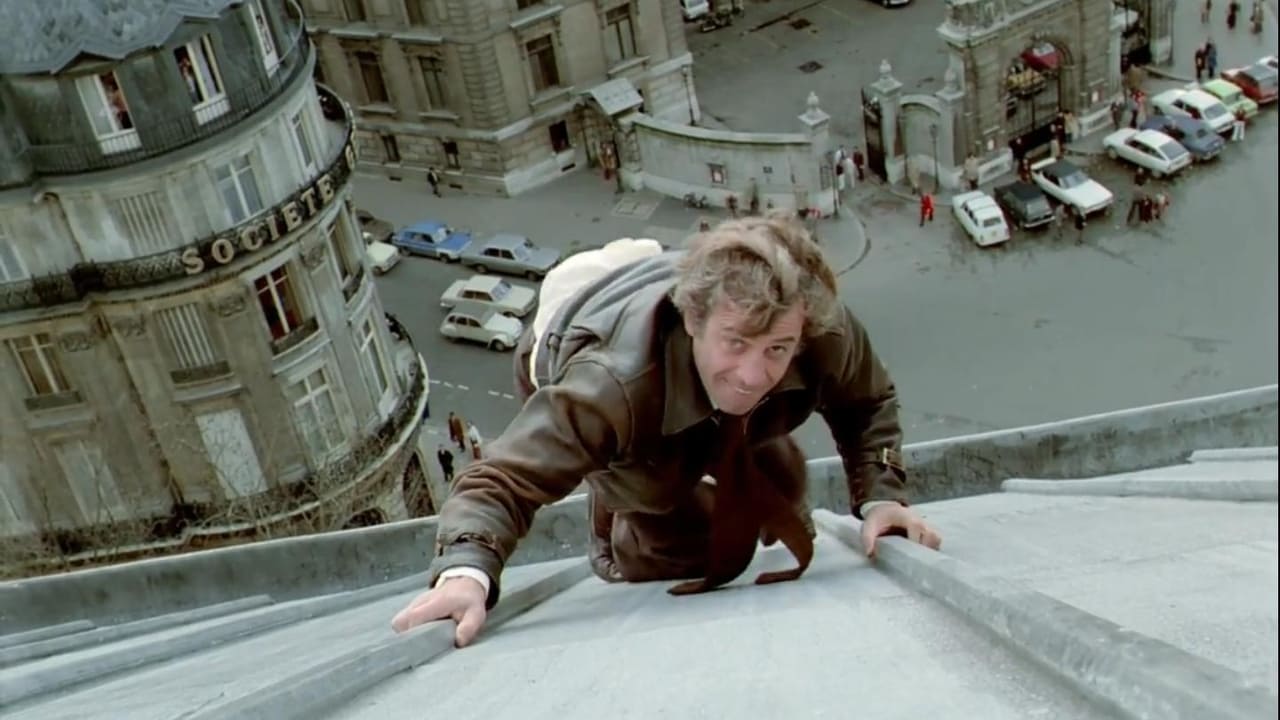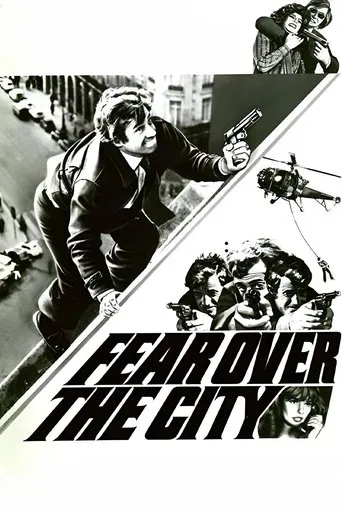

Oh, how I love the raw and gritty 70's action cinema! Most of it was all about rude and extremely unorthodox macho police detectives hunting down utterly deranged psychopaths that leave a trail of terror and bloodshed throughout the most major cities of our world. The US delivered a couple of brilliant milestones in the genre (like "Dirty Harry" and "The French Connection"), Italy is probably world record holder with all their masterful "Poliziotteschi" classics, and also France proudly owns a handful of goodies. Henri Verneuil's "Peur sur la Ville" is a prototypic 70's cop thriller, and this definition basically translates into: high adrenalin action from start to finish, straightforward but tense plot lines, cool cops, nightmarish criminals, sharp dialogs, pitch-black humor and an awesome soundtrack! J-P Belmondo is absolutely terrific as the dry and sarcastic Commissioner Letellier, charged with the case of a misogynic killer who menaces his victims via the phone prior to actually strangling them. Letellier is initially quite reluctant to lead the investigation, as he's too preoccupied with catching the bank robber that killed his previous partner, but then manages to conjoin the two man hunts. The killer, who baptized himself Minos, is a delightful lunatic with one creepy-looking glass eye and a rather peculiar opinion on femininity. "Peur sur la Ville" features many recurring highlights, like the many sardonic interactions between Commissioner Letellier and his partner Moissac, but of course the most obvious aspect to worship here is the action. Belmondo literally bounces around Paris, from the rooftops of apartment buildings to all the way down in the subway network. One particular chase sequence lasts for nearly twenty minutes and includes both of Letellier's suspect targets. Making it all even more impressive is the fact that J-P Belmondo performed his own stunts. Gazing at some of the set pieces, I can assure you that he repeatedly must have risked his neck throughout this production. Nearly forty years later now, films like "Peur sur la Ville" may indeed come across as somewhat dated and overly clichéd, but it's still tremendously exhilarating and entertaining. Besides, back then those clichés weren't clichés just yet. It's just indescribably charming and fun to watch car-chases featuring those typical light European automobiles making random casualties left, right and center. The climax is tense, albeit a bit tedious and overly stretched, and you won't notice for a second that this is actually quite long for an action/thriller (+120min). Last but definitely not least, the always reliable Ennio Morricone delivers a dazzling soundtrack as well. Hearing his eerie tones during the opening credits, and you just know you're about to witness an overall excellent movie.
... View More"Peur sur la ville" is one of the best films for both Jean-Paul Belmondo and director Henri Verneuil. At the time (1974-75) Belmondo is (with Alain Delon) the biggest French movie star -he's a versatile actor, but he is specialized in action movies where he can do his own stunts... His artistic and physical exploits allow him to be the Number 1 at the French box office between 1970 and 1987.Henri Verneuil is too a versatile artist -in his long career he directs film of every genre, most of them are box office hits. He works with the Top French film stars (Fernandel, Belmondo, Delon, Ventura, Gabin, ...).When the two men meet for this collaboration they are not novice artists and know exactly what they want. A solid thriller ("un polar") in the best French tradition with drama, fear and action. That's what they get and pack cinemas in many countries.Paris is frightened by a psychopath, whose name is Minos. This assassin punishes people who are (in his opinion) sinners... Commissaire Letellier is an athletic cop who reaches to catch him, in putting his life in danger many times.What else can I say? The merit of this movie is the simplicity. Because scenes are not exaggerated with special effects, they are not too violent as well. Efficacy of the movie depends on actors and their physical involvement.Belmondo, who is a mask of the French cinema, is really great. He can be funny and dramatical -in this film he's a charming tough character. He has a lighter approach than Clint Eastood's "Dirty Harry" or than any of Charles Bronson executioners.
... View MoreThis movie was a replacement in France. It marks the entry of a new criminal type(Minos) in a scenery unprecedented(the cold tower).The introduction is very efficient,a woman alone in her apartment,harass by the voice of Minos. Commissaire Letellier will be change his méthods for catch Minos. The opposition between the old-fashion criminal(Marcucci) and the modern(minos) is the symbol of a new area. The stunts are incredible(belmondo=keaton and Jackie Chan)specially the chase on the subway.The Veber's dialogues are very punchy. 8/10
... View MoreSkip through the special features on the DVD of Peter Yates Bullitt (1968) and you'll find an interesting featurette entitled Steve McQueen's Commitment to Reality; a promo made at the time of the film's production. As this quaint little curio unravels, we're told that McQueen had driven the iconic Ford Mustang for real, during the seminal car chases. The viewer is given the impression that the film's star is really something special for doing so. FACT: Next to French superstar Jean-Paul Belmondo's stunt work in Peur Sur La Ville, McQueen was merely dipping his little toe in a very deep pool! Reality indeed!The action sequences in Peur Sur La Ville are nothing short of jaw dropping, even by the standards of movies today. One chase sequence in particular has Belmondo pursuing a suspect up an interior stairwell, out through a window, across a series of rooftops whilst hanging onto various fascias and bits of guttering. Smashing through a skylight, he falls into a department store. Once again on street level, a car-chase ensues, climaxing with Belmondo running atop a moving train! Verneuil lets his audience know that it's his leading man putting his neck on the line. Belmondo is clearly seen, every step of the way. This is undoubtedly one of the best examples of its kind ever committed to celluloid.Peur Sur La Ville would probably never have been conceived if it hadn't been for the aforementioned Bullitt or for that matter, William Friedkin's The French Connection (1971).For years, European critics sneered at American remakes/reworkings of classic foreign language films and held theirs heads high with the view that continental cinema was not only innovative, but actually set the trends for the Yanks to replicate. However, Bullitt, French Connection and Don Siegel's Dirty Harry (1971) set the record straight once and for all; the anti-hero cop was as American as the hamburger. These groundbreaking films introduced audiences to unorthodox cops that had a case to break, by any means necessary. Sometimes these cops would act as ruthless as the criminals they were fighting to keep off the streets. All three films upped the ante in terms of action and break-neck editing.By the mid seventies, Italian directors such as Enzo G. Castellari (High Crime), Franco Martinelli (Violent Rome/Roma Violenta) Fernando De Leo (Calibre 9/Milano Calibre) and Umberto Lenzi (The Tough Ones/Italia a Mano Armata) were all dabbling with this new found genre. Whereas their American counterparts had cast the likes of Clint Eastwood, Charles Bronson and Gene Hackman, the Italians were making stars out of Franco Nero, Tomas Milian, Maurizio Merli and Fabio Testi. Although immensely enjoyable almost all of these Italian poliziers never rose above formulaic. However, Verneuil, a Turkish film-maker working in France managed to pull off a real coup with Peur Sur La Ville. By making his film a hybrid of both polizier and giallo, it works on both levels and gives it the substance lacking from the Italian pictures.A diabolical killer calling himself Minos, is on the loose in Paris. Having lived through the `free love' of the sixties and not getting any, he decides that he will `act as an arm of justice that will condemn without pity and execute all those who wallow in the sexual mud that is drowning us.' After establishing his motive, he sets about murdering promiscuous females. Hot on his heels is police Inspector Latelier (Belmondo). Minos taunts Latelier by sending a piece of his picture after each murder, in the view that the photograph will be complete when his work is done.As Paris' most unorthodox detective, Latelier gets sadistic pleasure from seeing his suspects squirming. During one of the Sub-plots, Latelier refuses to call a critically wounded drug dealer an ambulance until he gets the information he is after, which echoes Eastwood's Callaghan in Dirty Harry.As much as Verneuil was influenced by the like of Siegel and Freidkin, Peur sur La Ville owes a huge debt to the films of Mario Bava. The opening scene in which Minos taunts a victim on the phone, is reminiscent of The Telephone episode of Bava's anthology Black Sabbath (1963).Later during the aforementioned chase sequence, after crashing through the skylight, Latelier and Minos face off amongst the mannequins of a poorly lit store room; a nod to the Italian maestro's Hatchet for the Honeymoon (1969).Peur Sur La Ville features a wonderful music score by none other than Ennio Morricone. The score is integral to some of the set pieces as one would expect. During the tense opening, Morricone orchestrates only a single drumbeat. This is extremely unnerving, as we the audience, know that Minos is about to knock at the door!Canal + Video's DVD is presented anamorphically, in its original widescreen ratio of 1:66:1. This is as good a transfer as one could expect from a film of this age. Print damage is minimal but the colours seem a little washed-out. The sound is presented in two-channel mono, but is well balanced and serves Morricone's score well. The viewer has the choice of watching the film either in the original French language or in a dubbed English version. There are no subtitles available. Extra features are limited to the original theatrical trailer (in French), an interview with Verneuil (again in French) and a poster gallery.Peur Sur La Ville is one of the lost landmarks of action cinema but is also so much more. If you have a thing for poliziers or giallos, this ones for you!
... View More